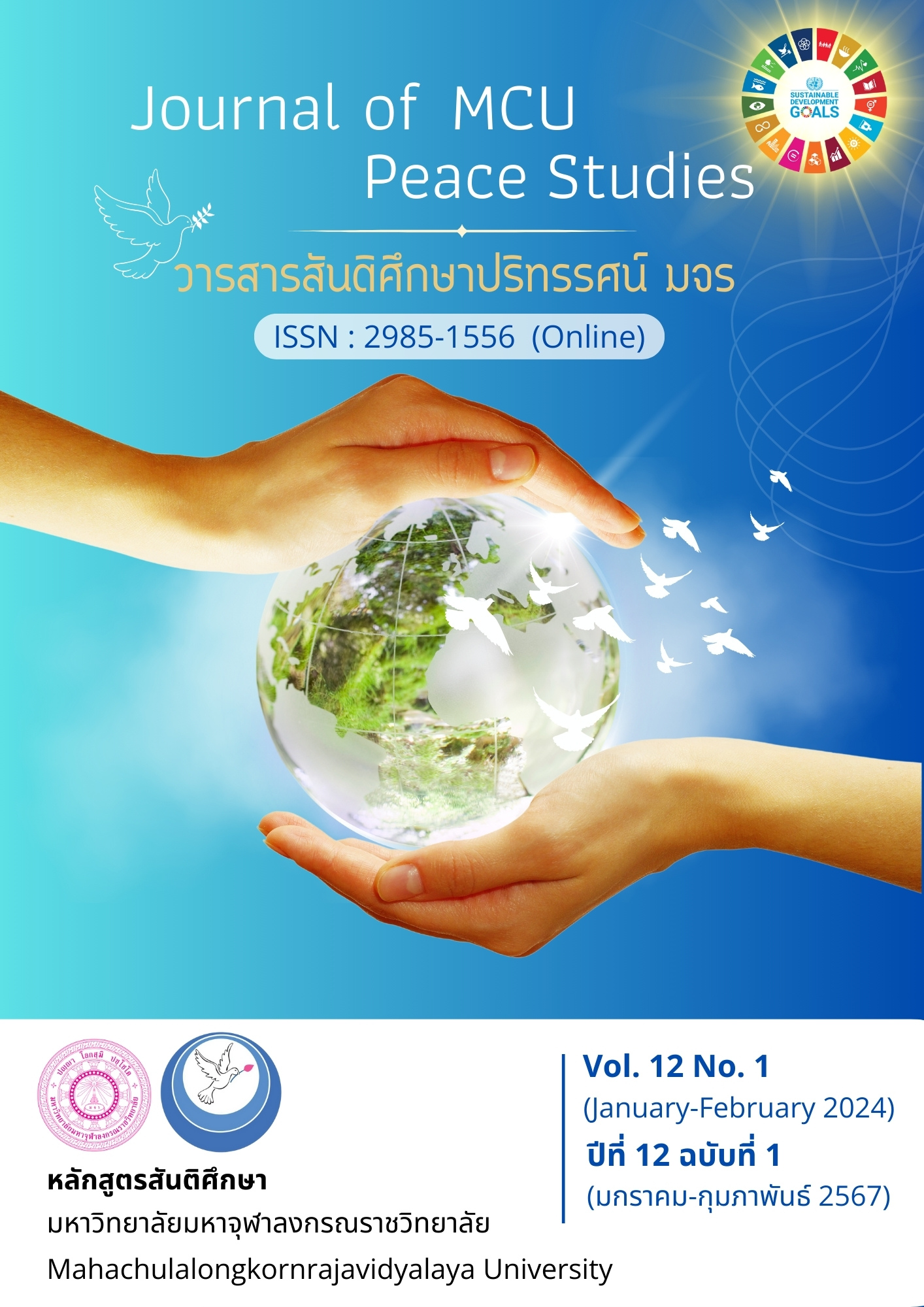พุทธสันติวิธีการสร้างสันติภายในสำหรับ “บุคลากรทางการแพทย์ผู้ให้การดูแลผู้ป่วยโรคมะเร็งแบบประคับประคองด้านจิตวิญญาณ”
Main Article Content
บทคัดย่อ
บทความวิจัยนี้มีวัตถุประสงค์ 1) เพื่อศึกษาสภาพปัญหา ความต้องการจำเป็นและหลักพุทธสันติวิธี (หลักการตามคำสอนของพระพุทธศาสนา ที่นำมาใช้ในการจัดการ ป้องกัน แก้ไข เยียวยาความขัดแย้งเพื่อให้เกิดสันติภายใน และภายนอก) ที่เอื้อต่อการสร้างสันติภายในของบุคลากรทางการแพทย์ผู้ให้การดูแลผู้ป่วยโรคมะเร็งแบบประคับประคองด้านจิตวิญญาณ 2) เพื่อนำเสนอพุทธสันติวิธีการสร้างสันติภายในสำหรับบุคลากรทางการแพทย์ผู้ให้การดูแลผู้ป่วยโรคมะเร็งแบบประคับประคองด้านจิตวิญญาณ ใช้การวิจัยแบบผสานวิธี แบบ Exploratory sequential design ด้วยการสัมภาษณ์เชิงลึกผู้ให้ข้อมูลสำคัญ 20 ท่าน คือบุคลากรทางการแพทย์ชาวพุทธผู้ให้การดูแลแบบประคับประคอง นักบวชและอาสาสมัครชาวพุทธ คริสต์ และมุสลิม ผู้ให้การดูแลผู้ป่วยระยะสุดท้าย จนข้อมูลมีความอิ่มตัว และสนทนากลุ่มเฉพาะผู้เชี่ยวชาญ 5 ท่าน จึงนำข้อมูลมาใช้สร้างหลักสูตรการอบรมการสร้างสันติภายในด้วยพุทธสันติวิธี และนำมาทดลองนำร่อง (Pre-experimental design)กับกลุ่มบุคลากรแพทย์ 16 ท่าน โดยใช้การคัดเลือกตัวอย่างแบบเจาะจง (Purposive Sampling) วัดผลด้วยแบบประเมินสันติภายในของบุคลากรแพทย์ การสะท้อนคิด วิเคราะห์ประเมินเชิงคุณภาพ และเชิงปริมาณด้วยค่าสถิติ t-test
ผลการวิจัยพบว่า 1) บุคลากรทางการแพทย์มีความกังวลใจถึง วิธีการช่วยเหลือเพื่อบรรเทาความรู้สึกกลัวการตายของผู้ป่วย การค้นหาความต้องการที่แท้จริง การสร้างสัมพันธภาพที่ดี วิธีการช่วยเหลือที่ไม่ขัดต่อความเชื่อของตนและผู้ป่วย เพราะเหตุจากการนำจิตวิญญาณทางการแพทย์ไปยึดติดกับศาสนาจึงทำให้กังวลถึง และพุทธสันติวิธีที่เอื้อต่อการสร้างสันติภายใน คือ (1) สติปัฏฐาน 4 (2) พรหมวิหาร 4 (3) สังคหวัตถุ 4 2) การนำหลักพุทธสันติวิธีที่ค้นคว้าได้ มาช่วยสร้างสันติภายในสำหรับบุคลากรทางการแพทย์ผู้ให้การดูแลผู้ป่วยโรคมะเร็งแบบประคับประคองด้านจิตวิญญาณ ผู้วิจัยได้สร้างหลักสูตรอบรมเพื่อพัฒนาสันติภายในโดยผ่านการสนทนากลุ่มย่อยเพื่อประเมินหลักสูตรโดยผู้เชี่ยวชาญทางพุทธศาสนา ผู้เชี่ยวชาญด้านการดูแลแบบประคับประคอง นักจิตวิทยา ผู้ฝึกสอนการฝึกอบรมสติ(Mindfulness Training Program) และ ด้านการสร้างหลักสูตรและหลักสูตรออนไลน์ โดยเป็นหลักสูตรแบบ Hybrid ด้วย ออนไลน์ 7 วัน และออนไซต์ 1 วัน เป็นการฝึกด้วยตนเองในชีวิตประจำวัน และ การปฏิบัติร่วมกับกลุ่มทุกวัน หลังทดลองพบว่า กลุ่มตัวอย่างสามารถมีสติในการจัดการอารมณ์ตนเองให้มีความสงบ มีเมตตาต่อตนเองและผู้ป่วย การฟังอย่างลึกซึ้งในการดูแลผู้ป่วยที่มีความเชื่อที่แตกต่าง ปล่อยวางตนเองได้เมื่อมีความทุกข์ และมีเครือข่ายกัลยาณมิตร กลุ่มตัวอย่างมีค่าเฉลี่ยสันติภายในสูงกว่าก่อนทดลองอย่างมีนัยสำคัญที่ระดับ .05
Article Details

อนุญาตภายใต้เงื่อนไข Creative Commons Attribution-NonCommercial-NoDerivatives 4.0 International License.
ทัศนะและความคิดเห็นที่ปรากฏในบทความในวารสาร ถือเป็นความรับผิดชอบของผู้เขียนบทความนั้น และไม่ถือเป็นทัศนะและความรับผิดชอบของกองบรรณาธิการ ยินยอมว่าบทความเป็นลิขสิทธิ์ของวารสาร
เอกสารอ้างอิง
Branstrom, R., Brandberg, Y., & Moskowitz, J. T. (2010). Self-report Mindfulness as a Mediator of Psychological Well-being in a Stress Reduction Intervention for Cancer Patients - A Randomized Study. Annals of Behavioral Medicine, 39, 151-161.
Branstrom, R., Kvillemo, P., & Moskowitz, J. T. (2012). A Randomized Study of the Effects of Mindfulness Training on Psychological Well-Being and Symptoms of Stress in Patients Treated for Cancer at 6 Month Follow-up. International Journal of Behavioral Medicine, 19(4), 535-542.
Bhikkhuni Niramisa. (2019). True Homecoming: A Collection of Dhamma Lectures by Thich Nhat Hanh in Thailand toward Peace and Reconciliation. Bangkok: Free Mind Publishing.
Carlson, L. E. (2013). Mindfulness-based Cancer Recovery: The Development of an Evidence-based Psychosocial Oncology Intervention. Oncology Exchange, 12(2), 21-25.
Carlson, L. E. et al. (2013). Randomized Controlled Trial of Mindfulness-based Cancer Recovery Versus Supportive Expressive Group Therapy for Distressed Survivors of Breast Cancer (MINDSET). Journal of Clinical Oncology, 31(25), 3119-3126.
Chmielewski, J., Los, K., & Luczynski, W. (2021). Mindfulness in Healthcare Professionals and Medical Education”. International Journal of Occupational Medicine and Environmental Health, 34(1), 1-14.
Hanh, T. N. (2012). Peace in Every Breath: How to Practice for People Who Don't Have Time. (Thandasatain, Translator). (3rd ed.). Bangkok: Free Mind Publishing.
Hanh, T. N. (2019). Silence: The Power of Stillness in a World Full of Distractions. (Kiatkampol, Translator). (2nd ed.). Bangkok: Free Mind Publishing.
Hfocus. (2022). Deep Dive into the Health System. Retrieved November 9, 2022, from https://www.hfocus.org/content/2022/11/26365
Johnson, R. B., & Christensen, L. (2004). Educational Research Quantitative, Qualitative, and Mixed Approaches. (5th ed.). Thousand Oaks: Sage.
Khumtaveeporn, P., Choocherd, P., & Sythipong, S. (2014). Comparison Between Praying and Listening to the Pray on Stress and Quality of Sleep in Breast Cancer Patients. Journal of the Royal Thai Army Nurses, 15(2), 386-394.
Magallón-Botaya, R. et al. (2021). Mindfulness in Primary Care Healthcare and Teaching Professionals and Its Relationship with Stress at Work: A Multicentric Cross-sectional Study. BMC Family Practice, 22, 1-9.
Mahachulalongkornrajavidyalaya University. (1996). Thai Tripitakas. Bangkok: MCU Press.
Morrow, E. H. et al. (2022). Comparison of Mindfulness Interventions for Healthcare Professionals: A Mixed-methods Study. Complementary Therapies in Medicine, 70(11), 1-7.
National Consensus Project for Quality Palliative Care. (2018). Clinical Practice Guidelines for Quality Palliative Care. Retrieved November 11, 2019, from http://www.nationalconsensusproject.org
Niu, Y., & Long, D. (2023). Manual Development and Efficacy of Mindful Living Group Activities to Promote Trauma Healing During the COVID-19 Pandemic in China. Front Public Health, 11, 1-11.
Phra Brahmagunabhorn (P.A. Payutto). (2013). Dictionary of Buddhism. Bangkok: Pali Dhamma Publishing Company.
Phramaha Hansa Dhammahaso (Niti Bunyakorn). (2011). Buddhist Peaceful Means. Bangkok: Century Publishing Company.
Phramaha Phutthiwat Panyataro, Phra Kan Kantadhammo, Phramaha Thongchai Thammathwee, & Kratoorerk, S. (2020). A Study of the Application of Buddhadham in the Service of Thai Traditional Medicine of Sisaket Hospital, Sisaket Province. Journal of MCU Ubon Review, 5(1), 250-259.
Plum Village Foundation, Thailand. (2011). Pray with Your Heart, Guide to Praying According to the Plum Village Guidelines. (4th ed.). Bangkok: Chanpen Publishing.
Renzenbrink, I. (2011). Caregiver Stress and Staff Support in Illness, Dying, and Bereavement. New York: Oxford University Press.
Santorelli, S. F. (n.d.). Mindfulness-based Stress Reduction (MBSR): Standard of Practice. Retrieved February 20, 2021, from http://www.umassmed.edu/cfm/stress-reduction/mbsr-standards-of-practice/
Sung, H. et al. (2021). Global Cancer Statistics 2020: GLOBOCAN Estimates of Incidence and Mortality Worldwide for 36 Cancers in 185 Countries. CA Cancer J Clin, 71, 209-249.
Suwanvecho, B. (2022). The Development of Peace Innovation for Empowering Metta and Karuna of Medical Personnel. (Doctoral Dissertation). Graduate School, Mahachulalongkornrajavidyalaya University. Ayutthaya.
Tashakkori, A., & Teddlie, C. (2003). Handbook of Mixed Methods in Social & Behavioral Research. Thousand Oaks: Sage.
World Health Organization. (2011). WHO Definition of Palliative Care. Retrieved November 3, 2019, from http://www.who.int/cancer/palliative/definition/en/


